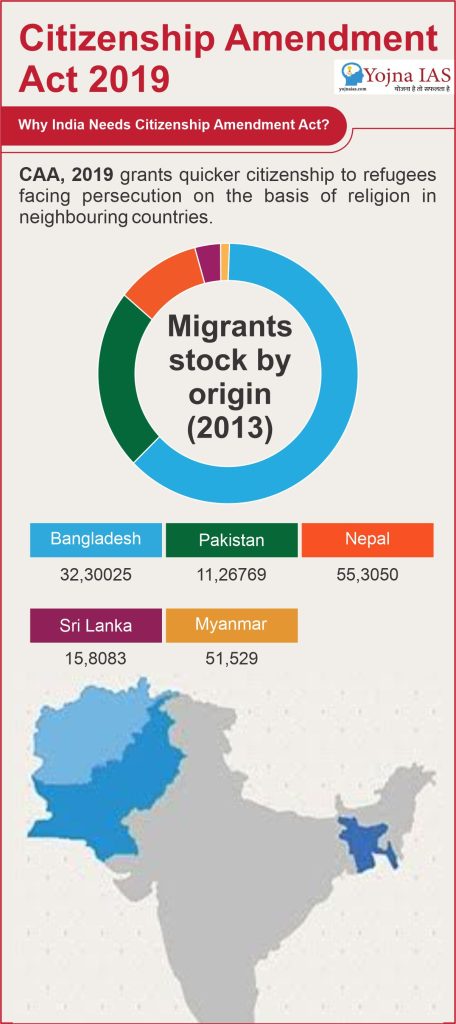13 Mar 2024 Centre notifies the implementation of CAA rules
This article covers ‘Daily Current Affairs’ and the topic details of ”Centre notifies the implementation of CAA rules”. This topic is relevant in the “Polity and Governance” section of the UPSC CSE exam.
Why in the News?
The Ministry of Home Affairs has notified the rules for the implementation of the Citizenship (Amendment) Act, which was passed by Parliament in December 2019.
About Citizenship Amendment Act (CAA) 2019
The Citizenship Amendment Act (CAA), passed in December 2019, has sparked significant debate and legal challenges in India. Here’s a deeper dive into the law’s provisions, the arguments surrounding it, and potential pathways forward.
Key provisions of the CAA
The CAA amends the Citizenship Act of 1955, creating a fast-track path to citizenship for undocumented immigrants belonging to six minority religions: Hindus, Sikhs, Buddhists, Jains, Parsis, and Christians. However, this expedited citizenship pathway comes with specific conditions:
- Eligibility Criteria: The beneficiaries must have entered India from Pakistan, Afghanistan, or Bangladesh before December 31, 2014, fleeing religious persecution in their home countries.
- Naturalisation Relaxation: The CAA reduces the minimum residency requirement for citizenship by naturalisation from eleven years to five years for these minority groups.
- Exemptions: Members of these communities are shielded from deportation or legal action under the Foreigners Act of 1946 and the Passport Act of 1920.
Important Exceptions
The CAA carves out exceptions for specific regions within India:
- Inner Line Permit System: Areas covered by the Inner Line Permit system in some northeastern states are exempt from the CAA’s provisions. This system safeguards the rights of indigenous communities by regulating entry and residency for outsiders.
- Sixth Schedule: The tribal areas protected under the Sixth Schedule of the Constitution are also not subject to the CAA. This schedule provides special provisions for these areas to preserve their unique cultures and traditions.
Recent Developments and Implementation
The Indian government has taken steps to streamline the application process for CAA benefits:
- Simplified Rules: New regulations have eased document requirements. The mandatory passport and visa provisions are eliminated. It provides a wider range of documents can be used as proof of entry and nationality.
- Centralised Processing: The application process is now overseen by a central government committee, limiting the role of state governments in citizenship decisions.

Arguments in Favour of CAA
Proponents of the CAA highlight several key benefits:
- Refugee Relief: The Act offers a lifeline to persecuted minorities who have faced religious discrimination and violence in neighbouring countries. It grants them a pathway to legal status and security in India.
- Protection of Identity and Rights: Citizenship ensures the cultural, linguistic, and social identities of these minorities are preserved. It also grants them economic and property rights, allowing them to fully integrate into Indian society.
- Addressing Historical Issues: The CAA is seen by some as a way to address the historical displacement of minorities due to the partition of India in 1947.
Criticisms and Concerns
Opponents of the CAA raise several crucial points:
- Violation of Equality: The core argument against the CAA is that it violates Article 14 of the Indian Constitution, which guarantees equality before the law. By prioritising religion as a criterion for citizenship, the CAA is seen as discriminatory towards other persecuted groups, particularly Muslims.
- Undermining Secularism: Critics argue that the CAA weakens India’s secular character, a core principle enshrined in the Constitution. By privileging specific religious minorities, the CAA is seen as departing from India’s tradition of religious tolerance and inclusion.
- Exclusion of Other Minorities: The Act’s exclusion of persecuted minorities like Tamil Hindus from Sri Lanka or Rohingya Muslims from Myanmar raises questions about its fairness and comprehensiveness.
- Northeastern Concerns: States in the northeast, with distinct cultural identities and limited resources, fear a potential influx of immigrants due to the CAA. They worry about the strain on infrastructure and the dilution of their cultural heritage.
- Assam Accord Anxieties: The CAA has sparked protests in Assam, where a previous agreement, the Assam Accord, set a deadline for identifying illegal immigrants. Critics argue that the CAA undermines this agreement and could lead to further demographic changes in the state.
Way Forward
Resolving the debate surrounding the CAA requires a multi-pronged approach:
- Addressing Muslim Concerns: The government must actively address anxieties within the Muslim community regarding a nationwide NRC (National Register of Citizens) and potential disenfranchisement. Assurances regarding fair and non-discriminatory implementation are crucial.
- Supreme Court Verdict: The Supreme Court of India is currently considering petitions challenging the constitutionality of the CAA. Its verdict will be a significant milestone in resolving the legal ambiguity surrounding the Act.
- International Reassurance: The Indian government needs to reassure neighbouring countries that the CAA’s implementation will not be discriminatory towards Muslims and will adhere to international norms.
- Expanding Scope (Potential): While the current CAA is limited to six religious minorities, future amendments
Prelims practise question
Q1. Consider the following statements:
- Only Hindus and Sikhs will get citizenship under the CAA,2019.
- To be eligible for being the beneficiary under the CAA, 2019, the person must have entered India before December 31, 2014, from any country.
Which of the above statements is/are correct?
(a) 1 only
(b) 2 only
(c) Both 1 and 2
(d) Neither 1 nor 2
ANSWER: D
Mains practise question
Q1. Analyse the exceptions carved out by the CAA for specific regions within India, such as the Inner Line Permit System and the Sixth Schedule. How do these exceptions aim to address concerns and protect the rights of indigenous communities?
I am a content developer and have done my Post Graduation in Political Science. I have given 2 UPSC mains, 1 IB ACIO interview and have cleared UGC NET JRF too.


No Comments